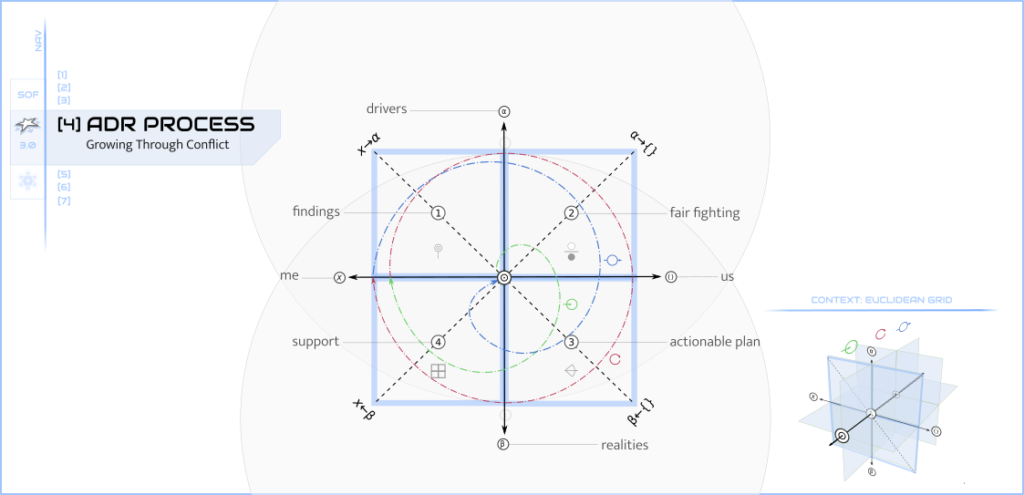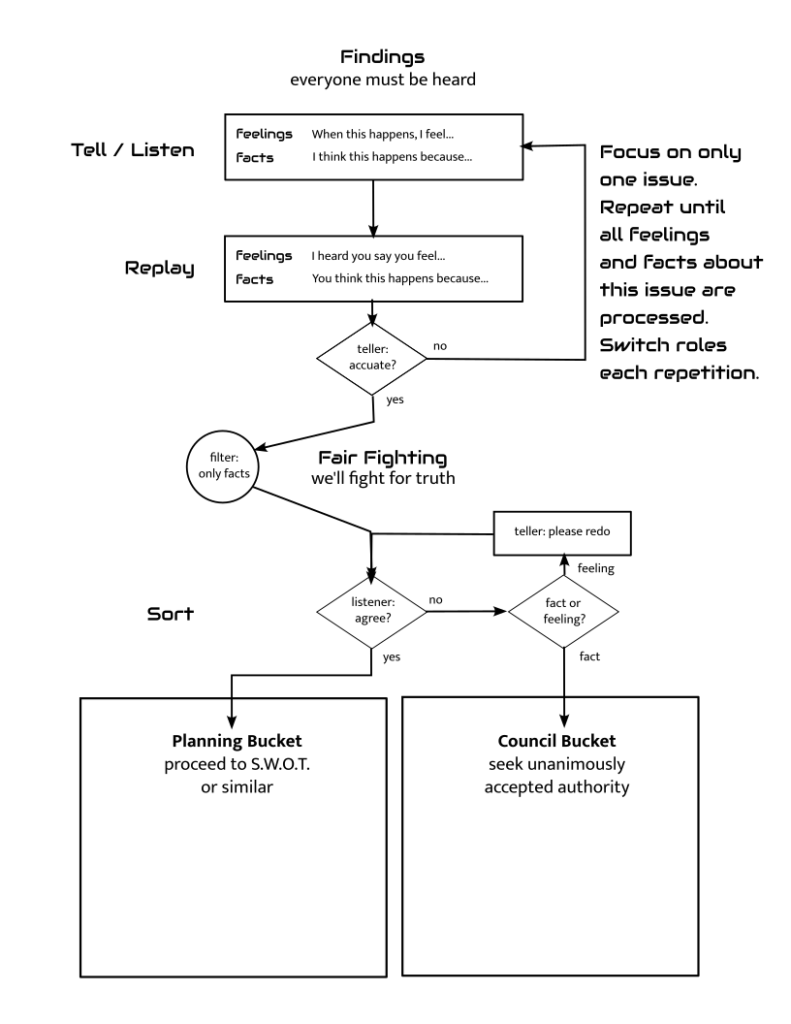
[4] ADR Process
ADR Process is a frame that outlines the process of Alternate Dispute Resolution (ADR) as an approach to conflict that is centered on skill development, personal growth, and collaborative problem solving. Alternate Dispute Resolutions is “alternate” in two senses: (1.) as the least destructive and intrusive intervention in a situation where negotiated agreement to the issue isn’t possible or has failed1, and (2.) as a less destructive and costly alternative to ending relationships and litigation. The process can be used in both formal and informal mediation processes with binding or non-binding resulting agreements or used by parties in conflict without mediation so long as the parties have developed the skills necessary to support the process.
ADR Perspective on What Causes Conflict
Conflict occurs when parties have relationships that contain some common interest, but cooperation for that interest is either unclear or undesired. In some cases, conflict can be cleared by the parties themselves becoming clear on cooperation or compromising or collaborating on desires.
When parties fail to do this on their own it is usually due to this key issue:
People fight to make themselves felt, not to get to the facts.
ADR is a rigorous process of dealing with emotions through active listening so the parties can get clear on the facts and compromise and/or collaborate. The process makes room for emotions (dominated by the Limbic System) by allowing them to be heard, then it asks the parties to transition to Executive Functions (working memory, mental flexibility, self control) to solve their problems.
When people encounter a problem and the solution is not clear due to incomplete information, disrupted or limited analysis, or lack of agreement, it is easy for the Prefrontal Cortext to “shut down” due to this lack of information and the brain to down-shift into the Limbic System for quicker impulse and/or emotion-driven thinking or to go into “panic mode” and trigger the Fight, Flight, or Freeze response. These lower levels of response are appropriate for survival situations, but tend to be destructive to relationships and come with anti-social consequences, especially in the long term.
| Level of Response | Brain Area |
|---|---|
| Executive Functions | Prefrontal Cortex |
| Impulse and Emotion | Limbic System |
| Fight, Flight, or Freeze (FFF) | Amygdala, sympathetic nervous system |
ADR Process is focused on engaging thinking on the Limbic System-dominated Impulse and Emotion response level through active listening, but then transitioning the parties to their Executive Functions for problem solving that can effectively change their situation. In cases where any party is in the FFF response, techniques of disarming this response and elevating the Level or Response will be required before the ADR Process can be used.
Four Process Stages and Four Core Values
Findings and Fair Fighting Flow Chart
The ADR Flowchart outlines to first two process stages using a rigorous procedure designed to discipline interactions towards Executive Function engagement of mutually-agreed upon facts. This procedure is composed of two loops connected by a filter.
Starting Point: Issue Identification
The process starts with identifying a single issue to work on. This issue needs to be simply stated in a single sentence. Although it may be proximal to other causes, only one issue can be in the process at one time. Notes can be made about further issues that need work, but the process will only work if both parties can focus on a single issue and develop one coherent plan.
The Findings Loop
Once the issue is identified, one party starts as the teller and the remaining party(s) as the teller. The teller is in control of this loop and the purpose is active listening and for the teller to verify the listener can accurately represent their feelings and facts.
The teller will offer one statement of how they feel in the following format:
When _________ happens, I feel…
This format intentionally states feelings in a way that frame problems as systemic issues in need of solving instead of personal failings in need of condemnation. This is important so that the listener’s brain can engage that statements as information to be curious about thus staying in Executive Functions. ”You did this” will trigger the risk/reward filter of the Limbic System and encourage the listener to process the statement on the level of Impulse and Emotion — which tends to be counter-productive for problem solving.
This statement of feeling will be followed by a statement the teller thinks is the underlying or core fact. At this point, the fact is not verified by the listener in any way — it is simply a proposed fact offered in the following format:
I think this happens because…
The Facts Filter
People need to be able to have and own there feelings, but feelings are not actionable. Facts are. Also, it is usually impractical for people to fight (even politely) about feelings since fighting will only reinforce a negative experience. People can however engage in a competitive discourse on facts and, though the process will involve some stress, they can feel good about the outcome because the agreed-upon facts will result in action.
Because of this, the transition between the two loops is a filter to only allow proposed facts into the Fair Fighting space.
The Fair Fighting Loop

Media




